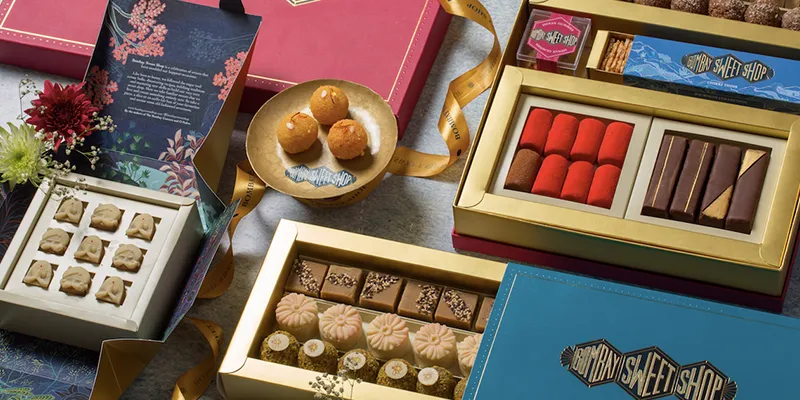Of sweetness and light: ‘People don’t just want sweets; they want an experience’
Festivities aren’t the same without mithai. Sameer Seth, Co-Founder of Bombay Sweet Shop, talks about innovation in sweets and how trends are changing.
The festive season is synonymous with a calorie overload. And strangely, none of us mind throwing caution to the winds when faced with golden ladoos topped with green pistachios and rose petals, silver-crowned kaju katlis, and milky barfis flavoured with orange zest and coconut slivers. Why even try to resist?

Yash Bhanage, Sameer Seth and late Chef Floyd Cardoz
Mithai is such an integral part of our lives that no festival – or wedding, birthday, and anniversary – is complete without it. But like us, traditional Indian mithai has also got a makeover these days.
YSWeekender caught up with Sameer Seth, Co-founder, Hunger Inc Hospitality, which owns Bombay Sweet Shop, O Pedro, and The Bombay Canteen, to understand the variety of sweets that are being prepared nowadays, how Indian sweets are being re-imagined with healthier modifications, and what are the shifting trends in festival sweets over the years.
Where it began

Assorted mithai boxes at Bombay Sweet House
Driven by the passion to build restaurants that fit the Indian context - socially and culturally – Sameer, along with his business partner, late Chef Floyd Cardoz and Yash Bhanage, developed the concepts behind all their outlets.
With a degree in chemistry from St Stephen’s College, New Delhi, and an MBA from Indian Institute of Management, Kozhikode, Sameer started off as a banker before realising that his interests lay elsewhere. Later, he joined Cornell University, Ithaca, US, to complete his master’s in hospitality management.
Bombay Sweet Shop offers a range of Indian sweets that are highly innovative. The chefs work at imaginatively reinterpreting a gamut of traditional Indian sweets and mithai in a contemporary and fun format. The philosophy at the heart of the store is all about viewing sweets through a whole new lens.
Sweets for the festival

Bombay Sweet Shop interiors
When asked about the innovative sweets that will be on offer during the festival season, Sameer says, “Our all-new Diwali offering includes the Lal Peda, inspired by Dulce de Leche and full of salted caramel and peanut brittle. The regional Doodh Boondi Ladoo is our take on the typical boondi ladoo from Jaipur, and is made with milk, besan, and rabri, flavoured with mace, and topped with pistachios and rose petals.”
Besides these sweets, they also have a North West winter mainstay, Dodha Burfi, which is a sprouted wheat-based burfi, but Sameer’s team has flavoured it with orange zest, coconut, and cinnamon, finished with white chocolate.
The two signature sweets this year are the Mighty Motichoor Ladoo and the Ferrero Rocker Ladoo, coated with toasted hazelnuts.
The company’s curated Diwali bags contain nuts, dry fruits, savouries, and exciting add-ons such as an art deco brass platter, Kashmiri saffron, and mithai-themed playing cards.
Re-imagining Indian sweets

Coconut caramel Patissa
“We believe that the process of re-imagining something comes from spending enough time understanding our traditions of sweets,” Sameer says.
According to Sameer, mithai - as a craft and technique - has barely been documented in a detailed manner. It has always been a craft form that was passed on from one generation much like other aspects of Indian cuisine.
“To understand traditions, we had to go to people’s houses, meet halwais, and convince them to show us what they knew,” he adds. “If you meet a local halwai, you will understand how particular they are about not sharing their knowledge. This entire research process itself took roughly two and a half years, and we put in a lot of effort just collecting all the information.”
The process of learning from scratch, cooking as per tradition, and mastering processes is what ultimately equipped the team with the ability to reimagine mithai.
New ways, old traditions

Innovative sweets are just as popular as the traditional ones
At Bombay Sweet Shop, the chefs begin by perfecting the sweet in its traditional form and then think of contemporary, fun ways to elevate it, either in the look or the flavour.
“This is not the case with all our mithai though,” Sameer says. “Certain Indian sweets are amazing as they are, and we have consciously chosen to keep them untouched. For example, our Motichoor Ladoos and Kaju Katlis. We spent months perfecting the traditional form and only after we figured that piece, we worked on how to incorporate chocolate into the boondi, so that each boondi had chocolate in it. This became our Bounty-ful Boondi Ladoo, which is inspired by the much-loved Bounty bar and combines the chocolate boondi with coconut.”
Local sources and seasons
The store sources besan so that they can control the coarseness and ensure that it is fresh. Other products are also acquired locally.
“Our Malai Peda has a filling of honey, rose, and figs. The figs and milk are sourced from farms in Nashik and ghee comes from Chitale in Pune. The cashew nuts we use come from the Konkan belt; they are sweeter than commercial counterparts and form the basis of our Kaju Katli,” he says.
New trends in festival sweets
“We are still learning about what guests want, since peoples’ mindsets change as per the occasion. For instance, our Patissa Bars and Chocolate Butterscotch Barks are ideal for that instant sweet craving and personal consumption whereas Diwali requires more traditional sweets,” Sameer says.
Among other trends in the love for sweets, people now don’t just want the wow factor from the product but also from the experience around it. COVID 19 has led to a shift towards improving personal health.
“We are working on having offering some healthier options but the process is not easy. It’s not as simple as replacing sugar with stevia. It takes a lot of research and a lot of trials until we achieve the result that we are happy with and equally delicious to serve,” Sameer says.
(Images credit: Bombay Sweet Shop)
Edited by Teja Lele









